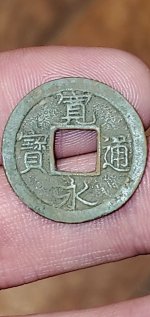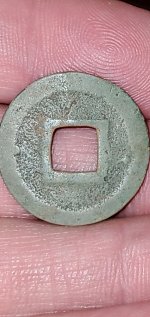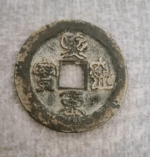I though I would start this thread about Chinese coins. So here we go.
Note: I found this info from a Chinese language video and a couple of Chinese language websites about coin research.
My first Chinese coin research discovery:
乾隆通宝 Qianlong tongbao.
A Chinese coin commonly found in North America while metal detecting.
There is a way to ballpark date some of the qianlong coins. These identifiable coins were minted at the end of his reign and during the start of the Jiaqing Emperor reign.
History:
From Wikipedia:
"In October 1795, the 60th year of his reign, the Qianlong Emperor announced his intention to abdicate in favour of Prince Jia. He made this decision because he felt that it was disrespectful for him to rule longer than his grandfather, the Kangxi Emperor, who was on the throne for 61 years. Prince Jia ascended the throne and adopted the era name "Jiaqing" in February 1796, hence he is historically known as the Jiaqing Emperor. For the next three years however, the Jiaqing Emperor was emperor in name only because decisions were still made by his father, who became a Taishang Huang (emperor emeritus) after his abdication."
Coin differences:
In 1796 because Qianlong Emperor was still in power two types of coins were minted: the new Jiaqing Emperor coins and a slightly different designed Qianlong coin. Six years into Jiaqing Emperor's reign (around 1802) they stopped minting Qianlong coins.
The difference:
The difference is in the "long" character 隆 . On the bottom right hand side of the long character has the characters 一 and 生 (yi and sheng). The yisheng coins are quite common. However, the 隆 long character bottom right approximately 1796-1802 had the character 山 shan.
Below are two photos with the differences. First one is a coin before 1796 with yisheng and the second one is 1796-1802 with shan.
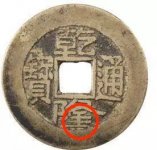
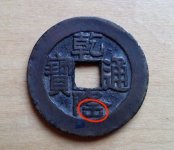
Note: I found this info from a Chinese language video and a couple of Chinese language websites about coin research.
My first Chinese coin research discovery:
乾隆通宝 Qianlong tongbao.
A Chinese coin commonly found in North America while metal detecting.
There is a way to ballpark date some of the qianlong coins. These identifiable coins were minted at the end of his reign and during the start of the Jiaqing Emperor reign.
History:
From Wikipedia:
"In October 1795, the 60th year of his reign, the Qianlong Emperor announced his intention to abdicate in favour of Prince Jia. He made this decision because he felt that it was disrespectful for him to rule longer than his grandfather, the Kangxi Emperor, who was on the throne for 61 years. Prince Jia ascended the throne and adopted the era name "Jiaqing" in February 1796, hence he is historically known as the Jiaqing Emperor. For the next three years however, the Jiaqing Emperor was emperor in name only because decisions were still made by his father, who became a Taishang Huang (emperor emeritus) after his abdication."
Coin differences:
In 1796 because Qianlong Emperor was still in power two types of coins were minted: the new Jiaqing Emperor coins and a slightly different designed Qianlong coin. Six years into Jiaqing Emperor's reign (around 1802) they stopped minting Qianlong coins.
The difference:
The difference is in the "long" character 隆 . On the bottom right hand side of the long character has the characters 一 and 生 (yi and sheng). The yisheng coins are quite common. However, the 隆 long character bottom right approximately 1796-1802 had the character 山 shan.
Below are two photos with the differences. First one is a coin before 1796 with yisheng and the second one is 1796-1802 with shan.






